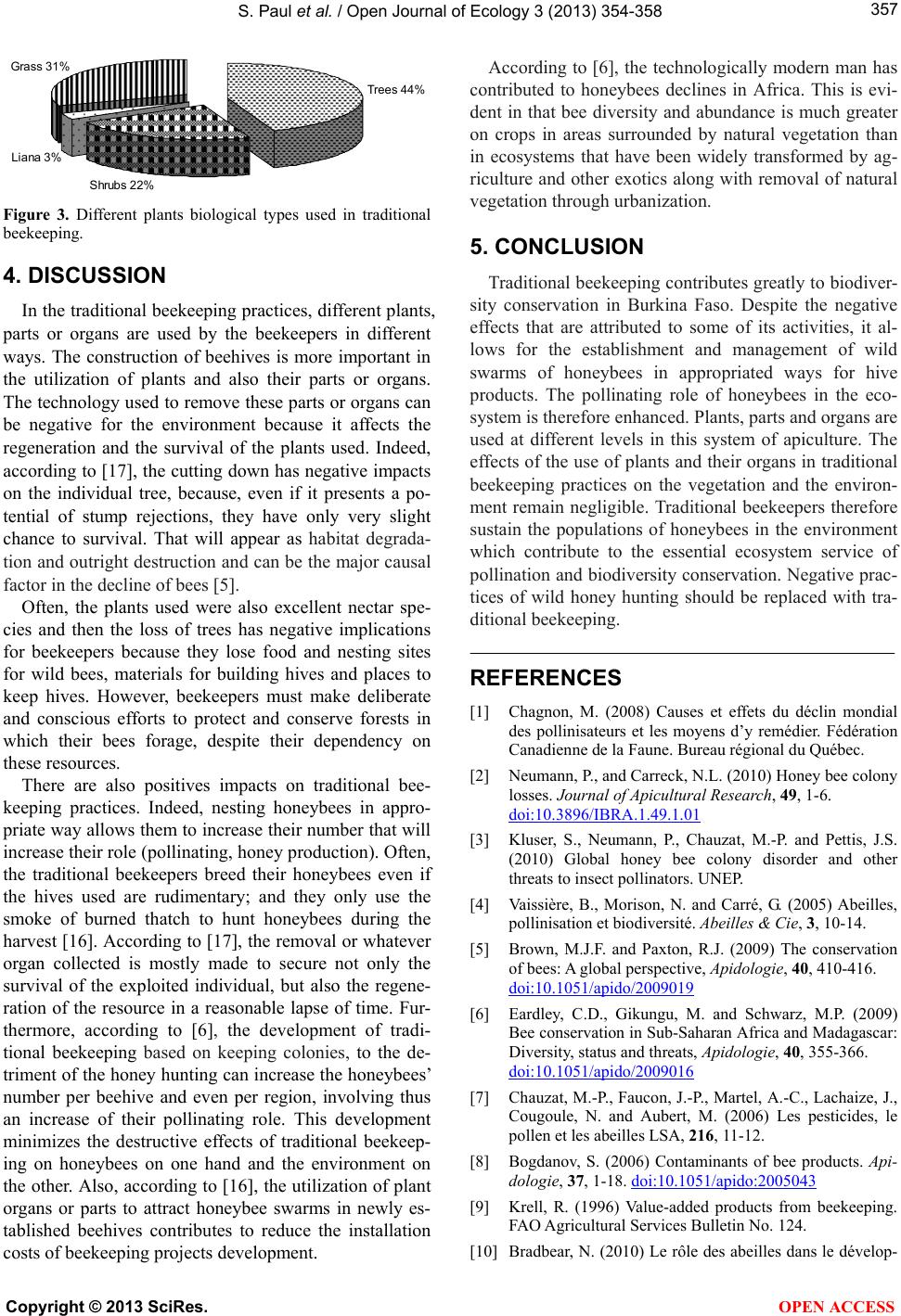
S. Paul et al. / Open Journal of Ecology 3 (2013) 354-358 357
Trees 44%
Sh r ubs 22%
Liana 3%
Grass 31%
Figure 3. Different plants biological types used in traditional
beekeeping.
4. DISCUSSION
In the traditional beekeep ing practices, different plants,
parts or organs are used by the beekeepers in different
ways. The construction of beehives is more important in
the utilization of plants and also their parts or organs.
The technology us ed to remove these parts or organs can
be negative for the environment because it affects the
regeneration and the survival of the plants used. Indeed,
according to [17], the cutting down has negative impacts
on the individual tree, because, even if it presents a po-
tential of stump rejections, they have only very slight
chance to survival. That will appear as habitat degrada-
tion and outright destruction and can be the major causal
factor in the decline of bees [5].
Often, the plants used were also excellent nectar spe-
cies and then the loss of trees has negative implications
for beekeepers because they lose food and nesting sites
for wild bees, materials for building hives and places to
keep hives. However, beekeepers must make deliberate
and conscious efforts to protect and conserve forests in
which their bees forage, despite their dependency on
these resources.
There are also positives impacts on traditional bee-
keeping practices. Indeed, nesting honeybees in appro-
priate way allows them to increase their number that will
increase their role (pollinating, hone y production). Often,
the traditional beekeepers breed their honeybees even if
the hives used are rudimentary; and they only use the
smoke of burned thatch to hunt honeybees during the
harvest [16]. According to [17], the removal or whatever
organ collected is mostly made to secure not only the
survival of the exploited individual, but also the regene-
ration of the resource in a reasonable lapse of time. Fur-
thermore, according to [6], the development of tradi-
tional beekeeping based on keeping colonies, to the de-
triment of the honey hunting can increase the honeybees’
number per beehive and even per region, involving thus
an increase of their pollinating role. This development
minimizes the destructive effects of traditional beekeep-
ing on honeybees on one hand and the environment on
the other. Also, according to [16], the utilization of plant
organs or parts to attract honeybee swarms in newly es-
tablished beehives contributes to reduce the installation
costs of beekeep i n g pr o ject s de vel o pment.
According to [6], the technologically modern man has
contributed to honeybees declines in Africa. This is evi-
dent in that bee diversity and abundance is much greater
on crops in areas surrounded by natural vegetation than
in ecosystems that have been widely transformed by ag-
riculture and other exotics along with removal of natural
vegetation through urbanization.
5. CONCLUSION
Traditional beekeep ing contributes greatly to biodiver-
sity conservation in Burkina Faso. Despite the negative
effects that are attributed to some of its activities, it al-
lows for the establishment and management of wild
swarms of honeybees in appropriated ways for hive
products. The pollinating role of honeybees in the eco-
system is therefore enhanced. Plants, parts and organs are
used at different levels in this system of apiculture. The
effects of the use of plants and their organs in traditional
beekeeping practices on the vegetation and the environ-
ment remain negligible. Traditional beekeepers therefore
sustain the populations of honeybees in the environment
which contribute to the essential ecosystem service of
pollination an d biodiversity conservation. Negativ e prac-
tices of wild honey hunting should be replaced with tra-
ditional bee kee pi n g.
REFERENCES
[1] Chagnon, M. (2008) Causes et effets du déclin mondial
des pollinisateurs et les moyens d’y remédier. Fédération
Canadienne de la Faune. Bureau régional du Québec.
[2] Neumann, P., and Carreck, N.L. (2010) Honey bee colony
losses. Journal of Apicultural Research, 49, 1-6.
doi:10.3896/IBRA.1.49.1.01
[3] Kluser, S., Neumann, P., Chauzat, M.-P. and Pettis, J.S.
(2010) Global honey bee colony disorder and other
threats to insect pollinators. UNEP.
[4] Vaissière, B., Morison, N. and Carré, G. (2005) Abeilles,
pollinisation et biodiversité. Abeilles & Cie, 3, 10-14.
[5] Brown, M.J.F. and Paxton, R.J. (2009) The conservation
of bees: A global perspective, Apidologie, 40, 410-416.
doi:10.1051/apido/2009019
[6] Eardley, C.D., Gikungu, M. and Schwarz, M.P. (2009)
Bee conservation in Sub-Saharan Africa and Madagascar:
Diversity, status and threats, Apidologie, 40, 355-366.
doi:10.1051/apido/2009016
[7] Chauzat, M.-P., Faucon, J.-P., Martel, A.-C., Lachaize, J.,
Cougoule, N. and Aubert, M. (2006) Les pesticides, le
pollen et les abeilles LSA, 216, 11-12.
[8] Bogdanov, S. (2006) Contaminants of bee products. Api-
dologie, 37, 1-18. doi:10.1051/apido:2005043
[9] Krell, R. (1996) Value-added products from beekeeping.
FAO Agricultural Services Bulletin No. 124.
[10] Bradbear, N. (2010) Le rôle des abeilles dans le dévelop-
Copyright © 2013 SciRes. OPEN ACCESS